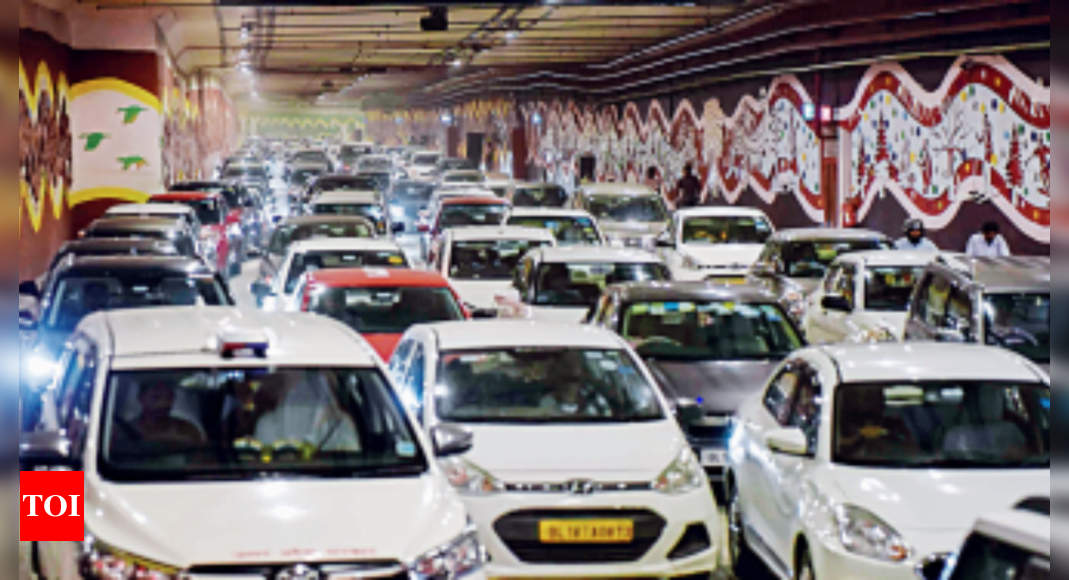NEW DELHI: The 1.36-km long Pragati Maidan tunnel, part of the Pragati Maidan redevelopment project, was conceived to ease traffic woes and cut down on the travel time of people moving from central Delhi areas to east Delhi, Noida and Ghaziabad. Just slide under the Capital’s ever-popular trade fair grounds, and presto, you will be on Ring Road in a few minutes, shaving off eight minutes from your original commute through Bhairon Road. It is, however, turning out to be a traffic trap, particularly during peak hours. In restropect, one wonders why the planners didn’t see this happening and try to iron out the design flaws besides learning from the traffic patterns and road conditions in the India Gate-C Hexagon area. TimesviewHaste makes waste is an old saying and, in this case, seems true as ever. The tunnel was meant to ease travel woes; instead, it has created a fresh set of problems, which should be taken note of. Solutions, even if temporary, must be provided immediately. In the meantime, the leftover work should also be completed at an expedited pace, which hopefully will end the glitchesCommuters are complaining that they are stuck inside the tunnel for 20-30 minutes every now and then. The problem is acute during evening hours and mostly affects the traffic moving from central Delhi towards east Delhi, Noida and Ghaziabad. TOI experienced this on three consecutive days. Ever since the tunnel was thrown open, at least two-thirds of the traffic at C-Hexagon, which is an eight-lane road, moves through Purana Qila Road to enter the tunnel which has three lanes on either side. The narrowing of the access starts right at the mouth of Purana Qila Road, in front of the Patiala House courts, where the road has just two lanes, barely stretchable to three, a feat the traffic police has been trying to achieve by shrinking the traffic island. The funnel effect creates a bottleneck at this point. Once the traffic enters the tunnel, it has three lanes available but the width of the carriageway is not uniform, varying from about 28.2 metres to 42 metres, leading to an uneven flow which proves to be a drag. Moreover, the tunnel is not straight but winding which, too, forces a drop in speed. When the traffic exits the tunnel for the loop towards Noida and Ghaziabad, it has to squeeze into two available lanes, causing a constriction once again. That is not the end of the commuters’ woes. The traffic has to emerge through a curved elevated ramp which requires slowing down. A big speed breaker at the end of the passage too reduces speed. Beyond it is the loop which too restricts speed. The cumulative effect of all this is a long tailback. The time taken to cross the tunnel is often close to half an hour. A traffic police officer said that at least 60 percent of the traffic from C Hexagon takes the tunnel and hence the traffic volume is quite high. Over one lakh motorists use it daily. Commuters are ruing the death of one more infrastructure project that looked so good on paper. “I am a daily user of the tunnel and it’s a traffic nightmare. After entering, I am barely able to move 50 metres before getting stuck. There is a pile-up of vehicles stretching to the exit and going towards Ring Road and Noida. It takes me least 15 to 20 minutes to cross this stretch daily. The speed breaker at the exit of the tunnel is one of the culprits, causing the vehicles to slow down,” said Ravinder Singh Chawla, who is a resident of Delhi and has a business in Noida. “Initially I was very happy to get access to this route which was reducing the commuting time to my office, but now, I get stuck daily, in the morning and evening. It’s the Noida side that’s really bad during the evening,” says Vishal, a resident of Noida who works in Delhi. Others are flagging issues of health and fire hazard. Ashwini Karkara, a member of Indian Society of Heating, Refrigerating and Air Conditioning Engineers, who uses the tunnel, explained that it was posing a health hazard as there was a carbon monoxide build-up inside the tunnel because of the congestion. “The other day I was shocked to find that the ventilation jet fans were not working (which should normally run on the basis of the carbon monoxide (CO) levels inside the tunnel). This could lead to a dangerous rise in CO levels (The major cause of CO is vehicular emissions),” he said. TOI has learnt from sources in Delhi Traffic Police that the issue of exhaust fans not functioning all the time has already been conveyed to India Trade Promotion Organisation (ITPO) and PWD. For such a long tunnel, another serious drawback is the absence of any cell connectivity inside. This could prove to be a critical lapse in case of an emergency, for instance a fire. The traffic police has asked the authorities to resolve the network issue as well as ensure a functional hotline number. The ITPO, which is the caretaker of the Pragati Maidan transit corridor, says about 30 per cent of the work on Underpass No.5, which is located on the Bhairon Marg-Ring Road junction, has to be completed and that will solve the problem in the traffic flow. “We are in regular touch with the officials of PWD and traffic police and just blaming PWD will not help. There is a fully functional fire safety mechanism inside the main tunnel. All the helplines are connected to the control room and are working. In case of an emergency, this facility is available for the commuters. The idea behind opening the tunnel, without waiting for completion of the work on Underpass No. 5, was to not make people wait but provide them some immediate relief,” said LC Goyal, chairman and managing director of ITPO.
Source: https://timesofindia.indiatimes.com/city/delhi/how-pragati-maidan-tunnel-stalls-progress/articleshow/93668319.cms

